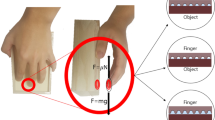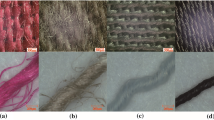Abstract
To achieve favorable Frictional Tactile Sensation (FTS) for robot and humanoid fingers, this report investigated the effects of human finger sweat on Friction Coefficient (FC) and verified the effectiveness of artificial sweat on FTS for a humanoid finger. The results show that the model sweat (salt and urea water faked real sweat) increases the FC of the real finger sliding on the high hygroscopic and rough surface (paper), whereas on the low hygroscopic and smooth surface (PMMA), the sweat forms a fluid film and decreases FC, restricting severe finger adhesion. Further, the film formation and capillary adhesion force of sweat were discussed. The experimental results with the artificial sweats (ethanol and water) and humanoid finger (silicone rubber skin with tactile sensors) verifies the effectiveness. The artificial sweat restricts severe adhesion (stick-slip vibration), and enhances cognitive capability of FTS.
Similar content being viewed by others
Abbreviations
- a:
-
radius of a droplet on a solid plane surface
- D c :
-
distance between solid surfaces (sweat film thickness)
- F:
-
raw data of finger friction force
- F̄:
-
average of finger friction forces at the consta finger load force
- f c :
-
Capillary Adhesion Force (CAF)
- f p :
-
capillary pressure force
- f s :
-
surface tension force
- g:
-
acceleration of gravity
- h:
-
film thickness (= a tan θd)
- hmin:
-
minimum film thickness (sweat)
- i, k:
-
integer variable for sigma
- L:
-
finger load force (normal force)
- m:
-
total count number of sampled-data at the constant finger load force
- n:
-
total count number of friction tests under individual conditions
- Ra:
-
calculated average roughness (JIS B 0601, 2001, in Japanese)
- r K :
-
radius of meniscus curvature (equal to the Kelvin’s radius)
- r w :
-
radius in water-solid contact
- S f :
-
contact area of a finger
- S w :
-
water contact area of a finger
- γ L :
-
surface tension of water
- θ:
-
equilibrium contact angle that the liquid makes with both solid surfaces
- θ d :
-
droplet contact angle on a solid plane surface
- σ:
-
equivalent surface roughness
- λ:
-
the film parameter (= h / σ)
- μ:
-
Friction Coefficient (FC)
- ̄μ:
-
average of friction coefficients at the constant finger load force
- ρ:
-
density of a droplet
References
Tomimoto M. Friction pattern for tactile sensor in anthropomorphic fingertip. Proceedings of the World Tribology Congress IV, Kyoto, Japan, 2009, 147.
Tomimoto M. The frictional pattern for tactile sensations in anthropomorphic fingertip. Tribology International, 2011, 44, 1340–1347.
Agache P, Hambert P. Measuring the Skin, Springer, 2004.
Schenck F W J. Outlines of Human Physiology, Henry Holt and Company, New York, USA, 1897.
Tomovic R, Boni G. An adaptive artificial hand. IRE Transactions on Automatic Control, 1962, 7, 3–10.
Bekey G A, Tomovic R, Zeljkovic I. Control architecture for the Belgrade/USC hand. In: Venkataraman S, Iberall T (eds). Dextrous Robot Hands, Springer-Verlag, New York, USA, 1990, 136–149.
Skedung L, Danerlöv K, Olofsson U, Aikala M, Niemi K, Kettle J, Rutland M W. Finger friction measurements on coated and uncoated printing paper. Tribology Letters, 2010, 37, 389–399.
Tomimoto M. Frictional effects of the artificial sweat on tactile sensations in the humanoid fingertip. Proceedings of International Tribology Conference, Hiroshima, Japan, 2011.
Tomimoto M. The artificial sweat for FTS in the humanoid finger. Proceedings of the International Symposium on Mechanobiology, Shanghai, China, 2011, 192.
Johnson S A, Gorman D M, Adam M J, Briscoe B J. The friction and lubrication of human stratum corneum. Proceedings of the 19th Leeds-Lyon Symposium on Tribology, Leeds, UK, 1993, 25, 663–672.
Adams M J, Briscoe B J, Johnson S A. Friction and lubrication of human skin. Tribology Letters, 2007, 26, 239–253.
Tomimoto M. Friction coefficient and sweat in human fingertip. Proceedings of JAST Tribology Conference, Fukui, Japan, 2010.
Warman P H, Ennos A R. Fingerprint are unlikely to increase the friction of primate fingerpads. Journal of Experimental Biology, 2009, 212, 2016–2022.
Tomlinson S E, Lewis R, Liu X, Texier C, Carré M J. Understanding the friction mechanisms between the human finger and flat contacting surfaces in moist conditions. Tribology Letters, 2011, 41, 283–294.
Pasumarty S M, Johnson S A, Watson S A, Adams M J. Friction of the human finger pad: Influence of moisture, occlusion and velocity. Tribology Letters, 2011, 44, 117–137.
André T, Lefèvre P, Thonnard J L. Fingertip moisture is optimally modulated during object manipulation. Journal of Neurophysiology, 2010, 103, 402–408.
Adams M J, Johnson S A, Lefèvre P, Léveque V, Hayward V, André T, Thonnard J-L. Finger pad friction and its role in grip and touch. Journal of Royal Society: Interface, 2013, 10, 20120467.
Montgomery D J. Static electrification of solids. Solid State Physics, 1959, 9, 139–197.
Derler S, Schrade U, Gerhardt L C. Tribology of human skin and mechanical skin equivalents in contact with textiles. Wear, 2007, 263, 1112–1116.
Gerhardt L C, Mattle N, Schrade G U, Spencer N D, Derler S. Study of skin-fabric interactions of relevance to decubitus: Friction and contact-pressure measurements. Skin Research and Technology, 2008, 14, 77–88.
Bhushan B. Tribology Issues and Opportunities in MEMS, Kluwer Academic Publishers, Dordrecht, the Netherlands, 1998.
Hoyland R W, Field R. A review of the transudation of water into paper, Part 2: The cellulose-water relationship, wetting and cutting angles. Paper Technology and Industry, 1976, 17, 216–219.
Hoyland R W, Field R. A review of the transudation of water into paper, Part 5: The mechanism of penetration, and conclusions. Paper Technology and Industry, 1977, 18, 7–9.
Verhoeff J, Hart J A, Gallay W. Sizing and the mechanism of penetration of water into paper. Pulp and Paper Magazine of Canada, 1963, 64, 509–516.
Salminen P J, Water transport into paper-the effect of some liquid and paper variables. TAPPI Journal, 1988, 9, 195–200.
Czichos H, Habig K H. Mixed lubrication and lubricated wear. In: Dowson D, Taylor C M, Godet M, Berthier D (eds). Proceedings of the 11th Leeds-Lyon Symposium on Tribology, Butter-worths, London, 1985, 135–147.
Derler S, Gerhardt L C. Tribology of skin: Review and analysis of experimental results for the friction coefficient of human skin. Tribology Letters, 2012, 45, 1–27.
Charlaix E, Ciccotti M. Capillary condensation in confined media. In: Sattler K (ed). Handbook of Nanophysics: Principles and Methods, CRC Press, Boca Raton, USA, 2010.
Mittal K L. Contact Angle, Wettability and Adhesion, VSP International Science Publishers, Leiden, the Netherlands, 2008.
Akinli-Kogak S. The Influence of Fiber Swelling on Paper Wetting, Master Thesis, Ankara University, Turkey, 1997.
Aspler J S. Interactions of ink and water with paper surface in printing. Nordic Pulp and Paper Research Journal, 1993, 1, 68–75.
Gerhardt L C, Strassle V, Lenz A, Spencer N D, Derler S. Influence of epidermal hydration on the friction of human skin against textiles. Journal of Royal Society: Interface, 2008, 5, 1317–1328.
Muhr A H. Lubrication of model asperities on rubber. Vehicle Tribology, 1991, 18, 195–204.
Author information
Authors and Affiliations
Corresponding author
Rights and permissions
About this article
Cite this article
Tomimoto, M. Artificial Sweat for Humanoid Finger. J Bionic Eng 11, 98–108 (2014). https://doi.org/10.1016/S1672-6529(14)60024-X
Published:
Issue Date:
DOI: https://doi.org/10.1016/S1672-6529(14)60024-X




